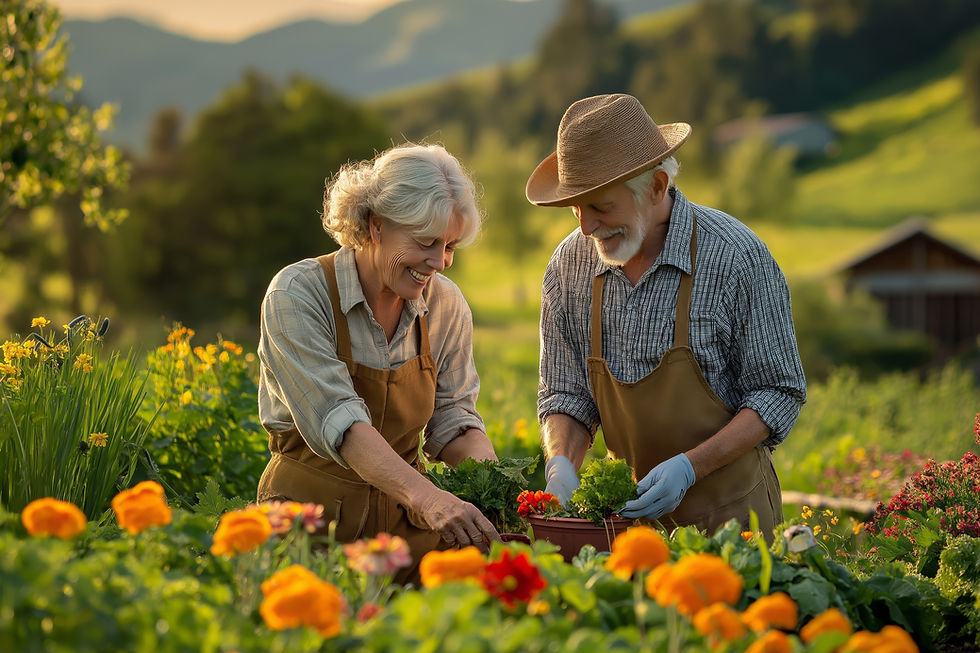Gardening Injury Prevention: A Physical Therapist’s Guide to Protecting Your Body
- amy45210
- Jul 14
- 3 min read
At Keystone Physical Therapy, we often see patients who love working in their garden—but come to us with back pain, knee stiffness, shoulder tightness, or wrist overuse. While gardening is a beneficial, low-impact activity, it involves repetitive movements, awkward postures, and heavy lifting—all of which can increase the risk of injury if not done properly.
The good news: With a few key modifications, you can continue gardening safely and even use it as a way to build strength, flexibility, and balance. These strategies are part of a comprehensive approach to gardening injury prevention that we regularly recommend in physical therapy.
Why Gardening Can Be Physically Demanding
Gardening may not seem strenuous, but over time it can take a toll on your joints and soft tissues. Here are some common reasons patients develop pain:

Prolonged bending or hunching over garden beds stresses the lower back
Squatting or kneeling for extended periods irritates the knees and hips
Lifting heavy bags or pots improperly strains the spine and shoulders
Gripping small tools tightly for repetitive tasks causes hand and wrist fatigue
6 Key Strategies for Gardening Injury Prevention
1. Start with a Proper Warm-Up
Before starting, spend 5–10 minutes on full-body movement. This might include:
A brief morning walk before jumping into your gardening routine
Gentle shoulder circles, hip openers, and spinal twists
Stretching your hamstrings and calves to support your back and legs
A warmed-up body is less prone to strains, particularly in the hips and lower spine.
2. Maintain Spinal Alignment During Tasks
When lifting or reaching:
Bend at the knees and hips, not the waist
Keep objects close to your body—don’t reach or twist while carrying
Use both hands and avoid rotating your spine under load
Avoid overloading your muscles: When lifting heavy objects, keep the weight manageable. If something feels too heavy to lift comfortably, don’t hesitate to ask for help or break the load into smaller, more manageable portions.
We often demonstrate safe body mechanics during physical therapy sessions to help prevent re-injury.
3. Elevate the Work Surface
To reduce strain on your back and knees:
Install raised beds (28–30 inches tall is ideal)
Use potting benches and vertical planters
Store tools at waist height so you don’t need to bend down repeatedly
Use self-watering systems: Drip irrigation or self-watering planters can save time and prevent repetitive bending and lifting heavy watering cans. These systems are especially helpful during warmer months when frequent watering is needed.
4. Use Ergonomic Tools and Supports
Simple upgrades can reduce repetitive strain:
Long-handled tools limit the need to bend
Cushioned or angled handles minimize wrist extension
Use a kneeling pad, rolling garden seat, or a low stool to support your posture
Look for lightweight tools designed specifically for individuals with arthritis or limited grip strength.
5. Limit Duration and Rotate Tasks
Avoid overloading one muscle group. Instead:
Work in 20–30 minute sessions, with breaks in between
Alternate between different tasks (digging, pruning, watering, etc.)
Stretch periodically and rehydrate often to prevent fatigue
Chronic overuse is one of the most common causes of pain in the spring gardening season.
6. Build Functional Strength
Working with a physical therapist can help you improve:
Core stability to protect the spine
Hip and glute strength for lifting and balance
Upper body mobility for overhead tasks
Grip and hand strength for tool use
At Keystone, we often design individualized home programs for patients who want to keep gardening safely.
When to Seek Help
If you experience persistent soreness, sharp pain, numbness, or joint swelling after gardening, it’s time to consult a provider. These could be early signs of:
Lumbar disc irritation
Tendonitis (especially in the wrist or elbow)
Shoulder impingement
Knee bursitis or meniscus strain
At Keystone Physical Therapy, our experienced physical therapists can evaluate your movement patterns, identify risks, and teach safe gardening techniques tailored to your body.
Ready to Get Back to Gardening?
Whether you're recovering from injury or just want to stay ahead of future aches, we're here to help. Contact us to schedule a one-on-one evaluation and get a personalized plan to stay active, independent, and pain-free in the garden—and beyond.



Comments